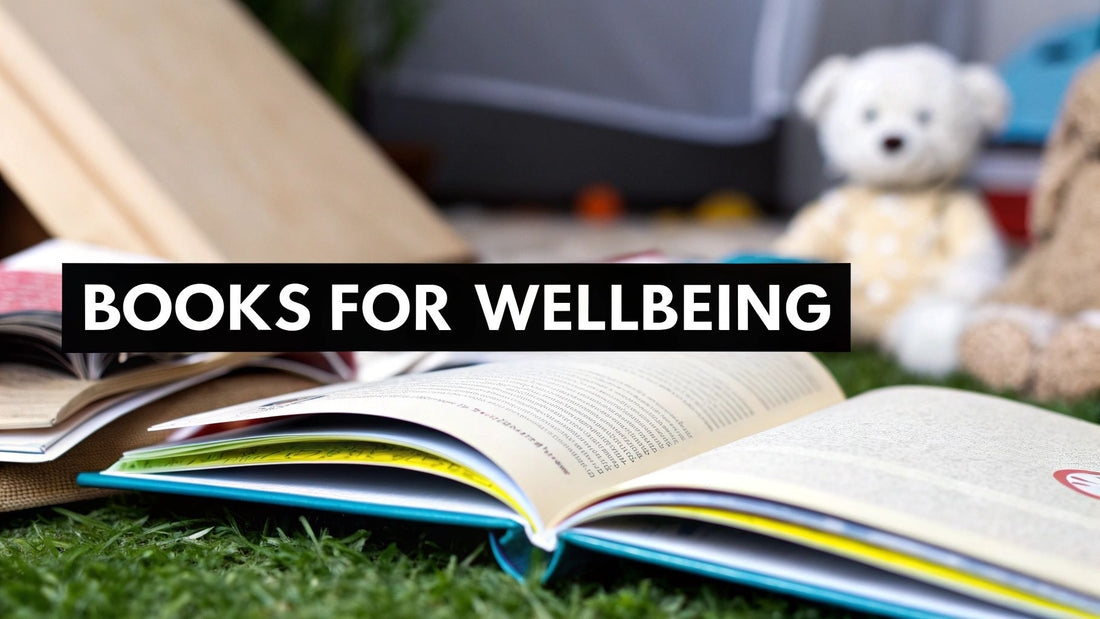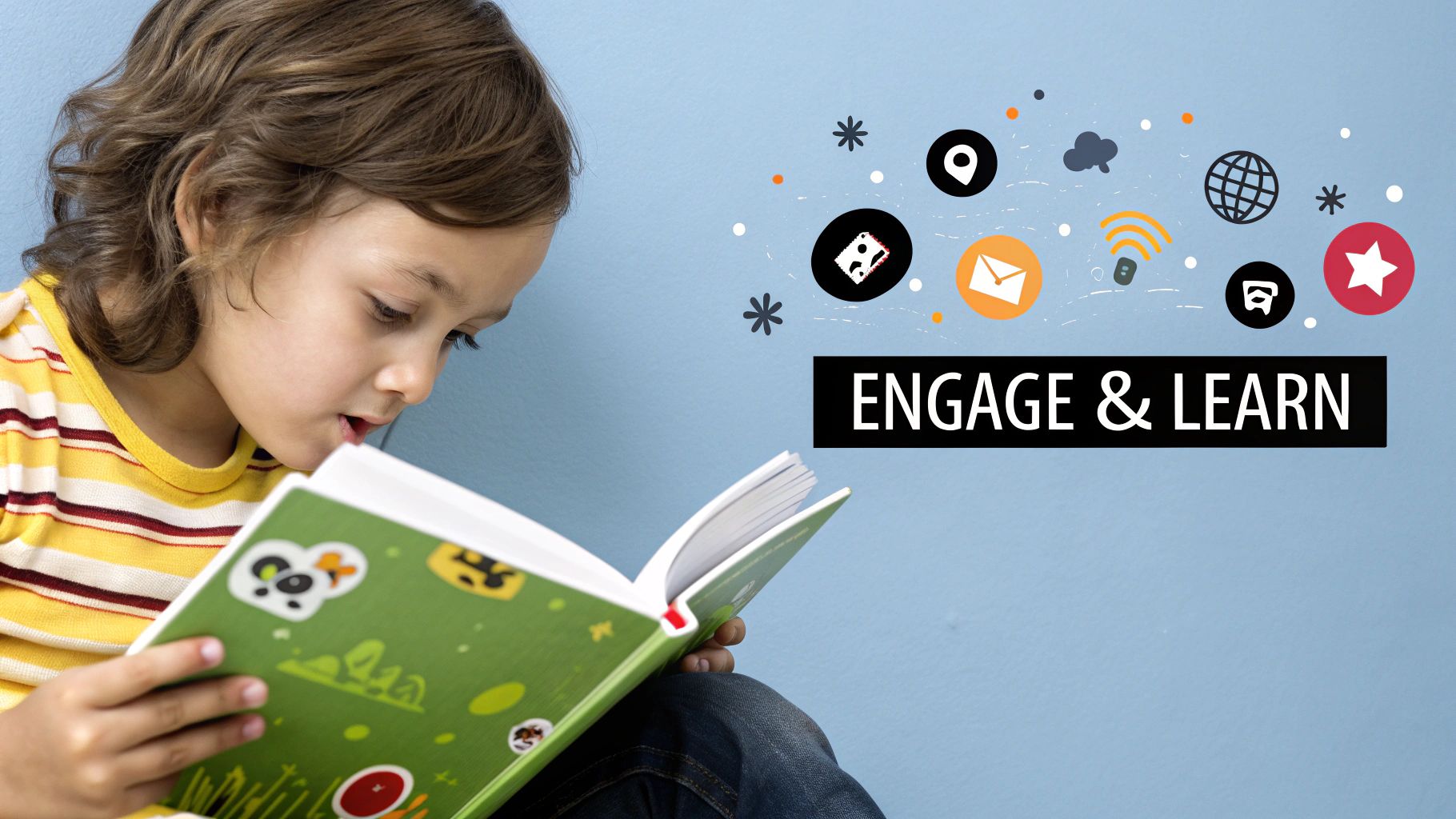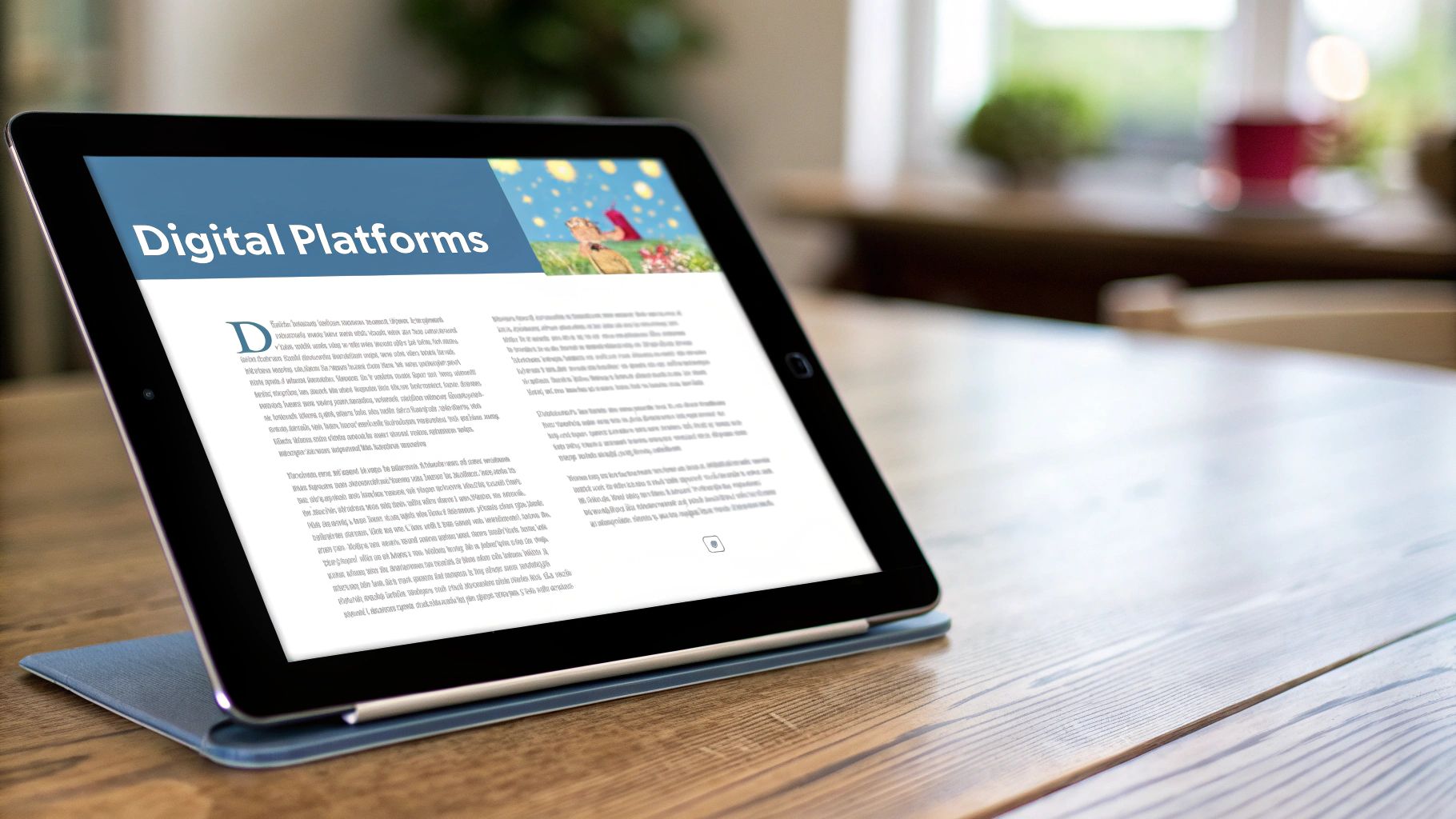
Interactive Children's Books for Better Wellbeing
Share
Interactive children's books are so much more than just stories with a few buttons or flaps to lift. Think of them as a bridge connecting classic storytelling with the kind of hands-on play children love. They are powerful tools for building emotional resilience and cognitive skills from a very young age, creating shared moments that strengthen the parent-child bond and make learning feel like pure fun.
The Power of Interactive Reading for Young Minds

In an age of constant digital noise, finding meaningful ways to connect with our children is more important than ever. The conversation around children’s mental health in the UK is growing louder, and for good reason. Recent figures show that one in five children now has a probable mental health condition, which really highlights the urgent need for supportive tools in early development.
This is exactly where shared reading experiences, especially with interactive children's books, can make a real difference. They completely change reading from a passive activity into an active, collaborative one. When a child lifts a flap to see what's hiding or presses a button to hear a sound, they are not just being entertained; they are stepping into the story.
Fostering Connection and Understanding
This active involvement does more than just keep their attention. It opens up a safe space for those vital conversations about feelings. A story about a nervous little bear heading to the woods can be the perfect, gentle opening to talk about your child’s own worries before their first day at school. For example, you could ask, "The bear seems a bit wobbly about going into the woods. Do you ever feel wobbly in your tummy before trying something new, like going to a party?"
By turning pages together, you are building more than just a story; you are building a foundation of trust and emotional security. This shared time reinforces that you are a safe person to turn to with big feelings.
To get a better sense of how this kind of engaged reading can boost a child's understanding, it's worth exploring these strategies to improve reading comprehension.
More Than Just a Story
The benefits go far beyond emotional development. Interactive reading is a natural fit for supporting cognitive growth. It encourages problem-solving, cause-and-effect thinking, and sharpens fine motor skills. Every single interaction is a small lesson in how the world works, delivered in a playful and memorable way.
While this guide offers practical advice on using books to support your child, please remember it is a supportive resource, not a substitute for professional help. I am not a mental health professional. If you have serious concerns about your child's wellbeing, it is always best to speak with your GP or a qualified specialist. They can provide the tailored guidance your family needs.
What Makes a Book Genuinely Interactive
Think of a standard children’s book as a bedtime monologue, a lovely story told to a child. An interactive children’s book, on the other hand, is a conversation. It pulls the child right off the sidelines and makes them an active player in the story, not just a passive listener. This simple shift turns reading from a one-way street into a dynamic, two-way adventure where the child's own actions can change what happens next.
This isn’t just about making reading more fun, though it certainly does that. It’s about making abstract ideas real and tangible. When a child touches a fuzzy patch of "fur" on a page about a lamb or lifts a flap to find a hidden character, they're physically connecting with the story. This multi-sensory approach is brilliant for helping new words and concepts stick, far more effectively than just hearing them spoken aloud.
Beyond Lifting the Flap
While classic lift-the-flap and touch-and-feel books are fantastic, true interactivity has grown to cover a huge range of formats. The magic ingredient is always the same: the child’s input creates an output. This simple, playful loop is a powerful way to teach them about cause and effect.
The diagram below shows how different features can be layered to create these wonderfully engaging experiences.

As you can see, the best interactive stories blend visual, audio, and tactile elements, all working together to pull a child deep into the world of the book.
To give you a clearer idea of the options out there, here’s a quick breakdown of the most common types of interactive books.
Types of Interactive Children's Books
| Book Type | Key Features | Best For Ages |
|---|---|---|
| Touch-and-Feel Books | Textured patches (fur, scales, glitter) for sensory exploration. | 0-2 years |
| Lift-the-Flap Books | Flaps reveal hidden images or text, encouraging curiosity. | 1-3 years |
| Pop-Up Books | Three-dimensional scenes emerge when pages are turned. | 2-5 years |
| Sound Books | Buttons trigger sounds, music, or narration. | 1-4 years |
| Digital/App Books | Animations, games, and responsive elements on a screen. | 3-7 years |
| Choose-Your-Own-Path | Readers make decisions that change the story's outcome. | 5-8 years |
Each format offers a unique way for a child to get involved, making the story feel truly their own.
Empowering Children with Choice
Perhaps the most powerful kind of interactivity is giving a child real agency within the story. This is a huge leap from simple physical actions to genuine decision-making, which is absolutely vital for their development. When you let a child influence the plot, you're not just entertaining them; you're teaching them that their choices have consequences. It’s a foundational lesson in emotional awareness, as explored in our guide on teaching emotional awareness to children.
When a child directs the narrative, they are not just reading a story. They're practising empathy, exploring different outcomes, and building problem-solving skills in a safe and supportive space.
A fantastic, and probably familiar, example of this is the idea behind creating choose-your-own-adventure stories. Whether it’s a physical book or a digital app, this format completely changes the game. It turns passive listening into active problem-solving and empowers children to see themselves as the heroes of their own journey.
Building Emotional Literacy One Page at a Time

Interactive reading is so much more than just a bit of fun; it’s a powerful way to build a child’s mental wellbeing from the ground up. At the heart of it all is the development of emotional literacy—the ability to recognise, understand, and then manage those big, confusing feelings.
This skill is just as crucial to a child's future as learning to read or write. It’s a sobering thought, but 75% of mental health problems are already established by the age of 24. Giving children these emotional tools early on is one of the greatest gifts we can offer them. It's vital to address mental health from a young age to build resilience for the future.
Think of it like this: a story about a character facing a challenge becomes a safe launchpad for real-world conversations. A book where a little fox gets lost, for example, can gently open up a dialogue about your child's own fears of being separated from you in a busy shop. It makes abstract emotions like anxiety feel more tangible, more manageable, and a whole lot less scary.
This is where interactive features really shine. When a child can physically touch a ‘sad’ textured page or choose the path for a brave character, they’re making a concrete connection with an otherwise invisible feeling. It’s a shared experience that takes the mystery out of complex emotions and strengthens that all-important parent-child bond.
Navigating the Modern World
Let’s be honest, addressing mental health from an early age is more important today than ever before. The constant hum of social media, even in the background of family life, can create subtle pressures and unrealistic comparisons that children inevitably pick up on. Building a strong foundation of emotional understanding helps them to navigate these external influences as they grow.
The importance of this stretches far beyond childhood. The cost of poor mental health to UK employers is estimated to be as high as £56 billion a year, thanks to burnout, absenteeism, and lost productivity. By teaching emotional regulation skills early, we are equipping the next generation with the tools they need for a healthier, more resilient future. For more on this, you can explore the many ways a children's mental health book can help your child.
Simple Relaxation Through Stories
Interactive books can also be a wonderful, gentle tool for teaching relaxation. The simple act of focusing on a shared story is a form of mindfulness in itself.
Here are a few practical tips you can try during story time:
- Match Breaths to Actions: Encourage your child to take a slow, deep breath every time they lift a flap or turn a page.
- Focus on Textures: In a touch-and-feel book, get them to describe the different surfaces. Is it rough? Bumpy? This sensory focus is incredibly grounding.
- Talk About Body Sensations: Ask questions like, "How do you think the happy lion feels in his tummy?" This helps them connect emotions to physical feelings.
These small, consistent practices can teach a child how to calm their own nervous system. It’s a superpower they’ll carry with them for life.
Please remember, I am not a mental health professional. These tips are for support and should not replace professional advice. If you are ever worried about your child's mental health, please seek help from your doctor or a qualified specialist.
How to Choose the Right Interactive Book

With so many options lining the shelves and filling up app stores, picking the perfect interactive children's book can feel a bit much. A flashy cover or a noisy sound effect does not automatically mean a book is the right fit. The trick is to look past the surface for stories with a real educational or emotional heart—something that will genuinely connect with your child.
The goal is always to find a book that makes reading a happy and enriching part of your day. This means choosing stories and features that click with your child’s unique personality and your family's values. After all, the best book is one that gets picked up again and again.
This huge market shows a massive demand for better educational content. In fact, the global children's publishing market is expected to hit $4.58 billion by 2025. Interactive books are a big part of this growth, prized for creating immersive experiences that boost literacy and thinking skills. If you're interested in the numbers, you can explore the full children's publishing market findings.
A Practical Checklist for Parents
To make your search a little easier, it helps to have a simple checklist in mind. Thinking about these key points will help you find a book that both captivates and supports your child. It’s not just about keeping them busy; it’s about choosing a tool that helps them grow.
Here’s a practical guide to help you make a great choice:
- Consider Age-Appropriateness: A book with complex digital features might just frustrate a toddler, while a simple touch-and-feel book will not keep a six-year-old interested for long. Make sure the book’s features match your child’s developmental stage.
- Follow Their Interests: Does your little one love dinosaurs, space, or animals? Choosing a book that taps into their passions is the easiest way to guarantee they'll be excited to read it.
- Check the Quality: For physical books, look for sturdy pages and bindings that can handle enthusiastic little hands. With digital books, check for easy navigation and high-quality animations and sounds that are not too distracting.
- Look for a Clear Message: The best interactive stories have a purpose. They might teach a lesson about kindness, introduce new words, or help a child make sense of a particular feeling.
Balancing Physical and Digital Books
In our screen-filled world, many parents worry about finding a healthy balance between traditional books and digital stories. The good news is that both have unique benefits. One is not necessarily better than the other; they just serve different purposes.
Physical interactive books are fantastic for sensory development and fine motor skills. Digital books, on the other hand, can offer dynamic storytelling and personalised learning paths that adapt to a child’s progress.
Ultimately, what matters most is the shared experience. Whether you're turning a cardboard page or tapping a screen, the connection you build during story time is what truly counts. By being thoughtful in your choices, you can make every reading session a positive step in your child's development.
Turning Story Time into a Calming Ritual
Reading together can be so much more than just ticking an educational box; it’s a powerful way to help your child relax. For a little one who's overstimulated or feeling anxious, the gentle rhythm of story time is like a signal to their brain that it's time to wind down. By consciously creating a peaceful routine, you can turn this daily moment into a cherished ritual that genuinely supports their mental wellbeing.
This is especially important in our non-stop world. All the constant stimuli can leave children feeling frazzled, and a quiet, shared activity is a much-needed reset button. An interactive children's book is the perfect anchor for this, as its hands-on nature helps ground a child, pulling them into the present moment.
Crafting a Peaceful Reading Nook
Having a specific space dedicated to reading helps build a really strong connection between books and calmness. It does not need to be anything elaborate—a cosy corner of their bedroom or the living room will do just fine. The real magic is in consistency and comfort.
Try adding a few of these simple touches:
- Cosy Seating: Think soft cushions, a comfy beanbag, or a warm blanket to make the space feel inviting and safe.
- Gentle Lighting: A small, warm lamp creates a much softer, more relaxed atmosphere than harsh overhead lights.
- Sensory Grounding: A touch-and-feel book can be incredibly soothing for a restless child. The simple act of tracing a texture can quieten a busy mind.
Mindful Reading Techniques
You can deepen the calming effect by pairing gentle stories with simple mindfulness exercises. This is not about sitting down for formal meditation, but more about weaving small moments of awareness into your reading time. For example, you could try linking a slow, deep breath to the turning of each page, creating a steady and peaceful rhythm together.
By focusing on the shared sensory experience of the book—the feel of the pages, the sound of your voice, the colours on the page—you help your child move away from overwhelming thoughts and into a state of quiet focus.
It’s really important to say that I am not a mental health professional. These are simply supportive suggestions that have helped others. If you're worried about your child’s anxiety or their overall mental health, it is crucial to seek help from your doctor or a qualified specialist.
You could also explore mental health books written specifically to talk about feelings, or even consider mental health apparel with positive affirmations to help normalise conversations around wellbeing. Every little step helps build a foundation of emotional security and openness.
A Guide to Further Support and Resources
Interactive books can be a fantastic way to open up conversations about feelings, but it's helpful to see them as just one tool in a much bigger toolkit. They're a brilliant aid on your child's emotional journey, but they're not a substitute for professional mental healthcare. The facts about children's mental health here in the UK are sobering, and reaching out for support is always a sign of strength.
If you have any worries at all about your child's wellbeing, the most important first step is to speak with your GP, a school nurse, or a qualified child mental health professional. They're the ones who can offer the specific, tailored guidance your family needs.
Finding Reliable Support
Trying to navigate the world of mental health support can feel overwhelming, but thankfully, there are many reputable charities and organisations out there. They offer excellent resources, sound advice, and often, just a listening ear. Think of them as brilliant starting points for finding information and a sense of community.
Beyond professional help, the conversation can, and should, continue at home. Our guide on four things you can do to support your child's mental health is packed with more practical tips you can weave into your daily life.
You can also find other creative outlets that complement this journey. For example, resources like interactive coloring pages for children can offer another wonderfully engaging and calming activity for young minds to explore their creativity.
Remember, you are not alone on this journey. Seeking support for your child, and for yourself, is a proactive and positive step towards building a resilient and emotionally healthy family.
Resources for Parents and Carers
Supporting your child means taking care of your own wellbeing, too. It’s impossible to pour from an empty cup. There's a growing selection of mental health books written specifically for parents, offering practical strategies and much-needed reassurance.
Even small things, like mental health apparel with positive affirmations, can help normalise these important conversations and act as gentle daily reminders to be kind to yourself.
Got Questions? We’ve Got Answers
Diving into the world of interactive books can bring up a few questions. It’s a brilliant way to support your child, but it's natural to wonder where to start. Here are some of the most common things parents and caregivers ask.
At What Age Can I Introduce Interactive Books?
You can start much earlier than you might think! Simple, tactile books can be introduced from a very young age, even around three to six months. Soft, fabric books or chunky board books with different textures are perfect at this stage. They’re all about engaging a baby’s developing senses and motor skills.
As your little one grows, you can bring in more complex features. Lift-the-flap and sound books are fantastic for curious toddlers. Digital stories and choose-your-own-path adventures are generally better suited for preschoolers and older children who are ready for more structured decision-making.
Are Digital Interactive Books Healthy Screen Time?
This is a really common concern, and it’s a valid one. The key here is all about quality and connection. Unlike just passively watching cartoons, a high-quality interactive storybook needs active participation, problem-solving, and decision-making from your child. It becomes a healthy form of screen time when you get involved, discussing the story and the choices together.
The most important thing is not the screen itself, but the shared experience. When you read together, you turn digital story time into a valuable moment of connection and learning.
How Can I Use a Book to Talk About Difficult Emotions?
First off, choose a book that features a character going through an emotion your child might be grappling with, like anger or sadness. Find a calm, quiet moment to sit down and read the story together.
Use the character’s feelings as a gentle way in. You could ask open-ended questions like, "The little bear seems really cross here, does he not? What do you think is making him feel that way?"
This approach lets your child explore the feeling from a safe distance before they have to connect it back to their own experiences, which can feel much less overwhelming.
Where Can I Find Book Recommendations I Can Trust?
Finding the right books to support mental wellbeing can feel like a big job, but there are some excellent places to look for trusted advice.
- Your Local Library: Children’s librarians are absolute goldmines of information and have a deep knowledge of age-appropriate books.
- School Resources: Do not hesitate to ask your child’s teacher or school counsellor; they often have a list of go-to titles.
- Reputable Charities: Organisations like YoungMinds or the Mental Health Foundation sometimes publish helpful book lists.
Here at Little Fish Books, we are passionate about creating resources that nurture emotional literacy from a young age. Feel free to explore our curated collection of books and activities, all designed to support your child’s mental wellbeing.
Discover our full range of emotional support books and resources at thatsokay.co.uk
